Techno-Economic Assessment of the Use of Syngas Generated from Biomass to Feed an Internal Combustion Engine
Abstract
1. Introduction
2. Experimental System Description
2.1. Downdraft Gasifier Description
2.2. Compact Generation System
3. Computational Model Set up
3.1. Fuel Characteristics
3.2. Mathematical Model
3.3. Chemical Reactions Model
4. Energy Analysis
5. Techno-Economic Analysis
Methodology
6. Results and Discussion
6.1. Experimental Runs and Model Validation
6.2. Energy Analysis Results
6.3. Economic Model Results
7. Sensitivity Analysis
7.1. Monte Carlo Simulation
7.2. Sensitivity Analysis Results and Discussion
8. Considerations on Small-Scale Biomass Gasification vs. Conventional Diesel Solutions
9. Conclusions
Author Contributions
Funding
Acknowledgments
Conflicts of Interest
Nomenclature
| calibration constants | |
| equation coefficient related to the main factors | |
| interception coefficient | |
| quadratic effects (give the curvature to the response surface) | |
| cross interactions between factors | |
| constants | |
| specific heat capacity | |
| cash flows | |
| diffusion rate coefficient | |
| generation of turbulence kinetic energy due to the mean velocity gradients | |
| generation of turbulence kinetic energy due to buoyancy | |
| gravitational acceleration | |
| h | specific enthalpy |
| heat transfer coefficient between the fluid phase and the solid phase | |
| radiation intensity | |
| diffusion flux of specie | |
| thermal conductivity | |
| lower heating value | |
| total mole flow of carbon in the syngas components | |
| molecular weight | |
| molecular weight of component | |
| biomass flow into the gasifier | |
| mass flow | |
| mass flow between the fluid phase and the solid phase | |
| Nusselt number | |
| particle phase pressure due to particle collisions | |
| gas pressure | |
| heat flux | |
| th | specific enthalpy |
| heat transfer intensity between phases | |
| heat rate | |
| universal gas constant | |
| net generation rate of specie due to homogeneous reaction | |
| reaction rate | |
| source term related to the specie production from the solid heterogeneous reaction | |
| user-defined source terms | |
| source term due to chemical reactions | |
| user-defined source terms | |
| temperature | |
| mean velocity | |
| instantaneous velocity | |
| work rate | |
| carbon fraction in the biomass (obtained from the ultimate analysis) | |
| mass fraction | |
| contribution of the fluctuating dilatation in compressible turbulence to the overall dissipation rate | |
| Other symbols | |
| volume fraction | |
| gas-solid interphase drag coefficient | |
| density | |
| granular temperature, proportional to the kinetic energy of the random motion of the particles | |
| energy exchange between the fluid phase and the solid phase | |
| diffusion energy ( is the diffusion coefficient) | |
| generation of energy by the solid stress tensor | |
| collisional dissipation of energy | |
| tensor stress | |
| viscosity | |
| stoichiometric coefficient | |
| efficiency | |
| Subscripts | |
| gas phase | |
| solid phase | |
| component | |
References
- Alsharif, M.H. Techno-economic evaluation of a stand-alone power system based on solar/battery for a base station of global system mobile communication. Energies 2017, 10, 392. [Google Scholar] [CrossRef]
- Pardo, J.E.; Mejías, A.; Sartal, A. Assessing the importance of biomass—Based heating systems for more sustainable buildings: A case study based in Spain. Energies 2020, 13, 1025. [Google Scholar] [CrossRef]
- APREN. Eletricidade Renovável. Panorama Energético Nacional; APREN: Lisboa, Portugal, 2017. [Google Scholar]
- Ministry of Mines and Energy. Resenha Energética Brasileira; Ministry of Mines and Energy: Brasilia, Brazil, 2018.
- Dudley, B.; Dale, S. BP Energy Economics. In BP Energy Outlook; BP: London, UK, 2018. [Google Scholar]
- Uddin, M.N.; Techato, K.; Taweekun, J.; Rahman, M.M.; Rasul, M.G.; Mahlia, T.M.I.; Ashrafur, S.M. An overview of recent developments in biomass pyrolysis technologies. Energies 2018, 11, 3115. [Google Scholar] [CrossRef]
- Ferreira, S.; Monteiro, E.; Calado, L.; Silva, V.; Brito, P.; Vilarinho, C. Experimental and modeling analysis of brewers’ spent grains gasification in a downdraft reactor. Energies 2019, 12, 4413. [Google Scholar] [CrossRef]
- Couto, N.; Silva, V.; Monteiro, E.; Teixeira, S.; Chacartegui, R.; Bouziane, K.; Brito, P.S.D.; Rouboa, A. Numerical and experimental analysis of municipal solid wastes gasification process. Appl. Therm. Eng. 2015, 78, 185–195. [Google Scholar] [CrossRef]
- Rinaldini, C.A.; Allesina, G.; Pedrazzi, S.; Mattarelli, E.; Savioli, T.; Morselli, N.; Puglia, M.; Tartarini, P. Experimental investigation on a Common Rail Diesel engine partially fuelled by syngas. Energy Convers. Manag. 2017, 138, 526–537. [Google Scholar] [CrossRef]
- Thi, T.; Huong, T.; Khanh, N.D.; Luong, P.H.; Tuan, L.A. A computational study of the effects of injection strategies on performance and emissions of a Syngas/Diesel dual-fuel engine. In Proceedings of the 5th AUN/SEED-Net Regional Conference on Global Environment, Bandung, Indonesia, 21–22 November 2012; pp. 379–392. [Google Scholar]
- Guo, H.; Neill, W.S.; Liko, B. The combustion and emissions performance of a syngas-diesel dual fuel compression ignition engine. In Proceedings of the ASME 2016 Internal Combustion Engine Fall Technical Conference, Greenville, SC, USA, 9–12 October 2016. ICEF 2016. [Google Scholar]
- Omar, M.M.; Munir, A.; Ahmad, M.; Tanveer, A. Downdraft gasifier structure and process improvement for high quality and quantity producer gas production. J. Energy Inst. 2018, 91, 1034–1044. [Google Scholar] [CrossRef]
- Boloy, R.A.M.; Silveira, J.L.; Tuna, C.E.; Coronado, C.R.; Antunes, J.S. Ecological impacts from syngas burning in internal combustion engine: Technical and economic aspects. Renew. Sustain. Energy Rev. 2011, 15, 5194–5201. [Google Scholar] [CrossRef]
- Dasappa, S.; Subbukrishna, D.N.; Suresh, K.C.; Paul, P.J.; Prabhu, G.S. Operational experience on a grid connected 100 kWe biomass gasification power plant in Karnataka, India. Energy Sustain. Dev. 2011, 15, 231–239. [Google Scholar] [CrossRef]
- Lee, U.; Balu, E.; Chung, J.N. An experimental evaluation of an integrated biomass gasification and power generation system for distributed power applications. Appl. Energy 2013, 101, 699–708. [Google Scholar] [CrossRef]
- Elsner, W.; Wysocki, M.; Niegodajew, P.; Borecki, R. Experimental and economic study of small-scale CHP installation equipped with downdraft gasifier and internal combustion engine. Appl. Energy 2017, 202, 213–227. [Google Scholar] [CrossRef]
- Cardoso, J.; Silva, V.; Eusébio, D.; Brito, P. Hydrodynamic modelling of municipal solid waste residues in a pilot scale fluidized bed reactor. Energies 2017, 10, 1773. [Google Scholar] [CrossRef]
- Silva, V.; Rouboa, A. Combining a 2-D multiphase CFD model with a Response Surface Methodology to optimize the gasification of Portuguese biomasses. Energy Convers. Manag. 2015, 99, 28–40. [Google Scholar] [CrossRef]
- Coronado, C.R.R.; Yoshioka, J.T.T.; Silveira, J.L. Electricity, hot water and cold water production from biomass. Energetic and economical analysis of the compact system of cogeneration run with woodgas from a small downdraft gasifier. Renew. Energy 2011, 36, 1861–1868. [Google Scholar] [CrossRef]
- Luz, F.C.; Rocha, M.H.; Lora, E.E.S.; Venturini, O.J.; Andrade, R.V.; Leme, M.M.V.; Del Olmo, O.A. Techno-economic analysis of municipal solid waste gasification for electricity generation in Brazil. Energy Convers. Manag. 2015, 103, 321–337. [Google Scholar] [CrossRef]
- Raman, P.; Ram, N.K. Performance analysis of an internal combustion engine operated on producer gas, in comparison with the performance of the natural gas and diesel engines. Energy 2013, 63, 317–333. [Google Scholar] [CrossRef]
- Indrawan, N.; Thapa, S.; Bhoi, P.R.; Huhnke, R.L.; Kumar, A. Engine power generation and emission performance of syngas generated from low-density biomass. Energy Convers. Manag. 2017, 148, 593–603. [Google Scholar] [CrossRef]
- La Villetta, M.; Costa, M.; Cirillo, D.; Massarotti, N.; Vanoli, L. Performance analysis of a biomass powered micro-cogeneration system based on gasification and syngas conversion in a reciprocating engine. Energy Convers. Manag. 2018, 175, 33–48. [Google Scholar] [CrossRef]
- Chang, C.T.; Costa, M.; La Villetta, M.; Macaluso, A.; Piazzullo, D.; Vanoli, L. Thermo-economic analyses of a Taiwanese combined CHP system fuelled with syngas from rice husk gasification. Energy 2019, 167, 766–780. [Google Scholar] [CrossRef]
- Cardoso, J.; Silva, V.; Eusébio, D. Techno-economic analysis of a biomass gasification power plant dealing with forestry residues blends for electricity production in Portugal. J. Clean. Prod. 2019, 212, 741–753. [Google Scholar] [CrossRef]
- Brito, P.; Calado, L.; Garcia, B.; Alves, O.; Samanis, M. A Critical Review on Acacia Gasification and Mix Acacia/Tires Co-Gasification, and Their Energy Assessments; IPP: Portalegre, Portugal, 2017.
- The Global Leader in Small-Scale Gasification. Available online: https://www.allpowerlabs.com (accessed on 15 March 2020).
- Couto, N.; Silva, V.; Cardoso, J.; Rouboa, A. 2nd law analysis of Portuguese municipal solid waste gasification using CO2/air mixtures. J. CO2 Util. 2017, 20, 347–356. [Google Scholar] [CrossRef]
- De Sales, C.A.V.B.; Maya, D.M.Y.; Lora, E.E.S.; Jaén, R.L.; Reyes, A.M.M.; González, A.M.; Andrade, R.V.; Martínez, J.D. Experimental study on biomass (eucalyptus spp.) gasification in a two-stage downdraft reactor by using mixtures of air, saturated steam and oxygen as gasifying agents. Energy Convers. Manag. 2017, 145, 314–323. [Google Scholar] [CrossRef]
- Couto, N.; Silva, V.; Monteiro, E.; Rouboa, A. Exergy analysis of Portuguese municipal solid waste treatment via steam gasification. Energy Convers. Manag. 2017, 134, 235–246. [Google Scholar] [CrossRef]
- CEPEA (Centro de Estudos Avançados em Economia Aplicada). Setor Florestal; CEPEA: São Paulo, Brazil, 2018; Volume 93. [Google Scholar]
- Ferreira, A.L.D. Culturas Energéticas: Produção De Biomassa E Bioenergia; Universidade de Coimbra: Coimbra, Portugal, 2015. [Google Scholar]
- Ferreira, S.; Monteiro, E.; Brito, P.; Vilarinho, C. Biomass resources in Portugal: Current status and prospects. Renew. Sustain. Energy Rev. 2017, 78, 1221–1235. [Google Scholar] [CrossRef]
- Bilek, E.M.; Skog, K.E.; Fried, J.; Christensen, G. Fuel to Burn: Economics of Converting Forest Thinnings to Energy Using BioMax in SOUTHERN Oregon; U.S. Dept. of Agriculture, Forest Service, Forest Products Laboratory: Madison, WI, USA, 2005.
- ERSE. Proveitos Permitidos e Ajustamentos Para 2019 Das Empresas Reguladas do Setor Elétrico; ERSE: Lisboa, Portugal, 2019.
- ANEEL. Relatório Pesquisa Iasc 2018 Brasil, Categorias e Distribuidoras; ANEEL: Brasilia, Brazil, 2019.
- Abrantes, J.M. Avaliação Técnica e Económica da Aplicação de Sistemas Waste to Energy no Tratamento de Resíduos Urbanos em Aglomerados de Média e Pequena Dimensão; Instituto Superior Técnico Lisboa: Lisboa, Portugal, 2016. [Google Scholar]
- Ministerio das Finanças. Guia Fiscal 2019; Ministério das Finanças: Lisboa, Portugal, 2019.
- Receita Federal do Brasil. Capítulo XIII—IRPJ—Lucro Presumido 2017; Receita Federal do Brasil: Brasilia, Braszil, 2017.
- Lyons, W.C.; Plisga, G.J.; Michael, D. Lorenz Petroleum Economic Evaluation. In Standard Handbook of Petroleum and Natural Gas Engineering; ELSEVIER: Amsterdam, The Netherlands, 2016; pp. 7-1–7-55. ISBN 9780123838469. [Google Scholar]
- Investopedia Corporate Finance & Accounting. Available online: https://www.investopedia.com/terms/c/cfat.asp (accessed on 4 June 2020).
- Diário da República. Decreto Regulamentar n.o 25/2009 de 14 de Setembro. Diário da República, 1.a Série—N.o 178—11 de Setembro de 2015; Diário da República: Lisboa, Portugal, 2009.
- ANEEL Biomassa. Atlas de Energia Elétrica no Brasil; ANNEL: Brasilia, Braszil, 2005; Volume 5, pp. 77–92. ISBN 978-85-87491-10-7.
- BBC. Los Países de América Latina Donde se Pagan Más y Menos Impuestos—BBC News Mundo. Available online: https://www.bbc.com/mundo/noticias-47572413 (accessed on 10 March 2020).
- Cardoso, J.; Silva, V.; Eusébio, D.; Brito, P.; Tarelho, L. Improved numerical approaches to predict hydrodynamics in a pilot-scale bubbling fl uidized bed biomass reactor: A numerical study with experimental validation. Energy Convers. Manag. 2018, 156, 53–67. [Google Scholar] [CrossRef]
- Silva, V.; Monteiro, E.; Couto, N.; Brito, P.; Rouboa, A. Analysis of syngas quality from Portuguese biomasses: An experimental and numerical study. Energy Fuels 2014, 28, 5766–5777. [Google Scholar] [CrossRef]
- Cardoso, J.; Silva, V.; Eusébio, D.; Brito, P.; Hall, M.J.; Tarelho, L. Comparative scaling analysis of two different sized pilot-scale fluidized bed reactors operating with biomass substrates. Energy 2018, 151, 520–535. [Google Scholar] [CrossRef]
- Homdoung, N.; Tippayawong, N.; Dussadee, N. Performance and emissions of a modified small engine operated on producer gas. Energy Convers. Manag. 2015, 94, 286–292. [Google Scholar] [CrossRef]
- Glenting, C.; Jakobsen, N.F.B. Converting Biomass to Energy. A Guide for Developers and Investors; World Bank Group: Washington, DC, USA, 2017. [Google Scholar]
- Vera, D.; Jurado, F.; Margaritis, N.K.; Grammelis, P. Experimental and economic study of a gasification plant fuelled with olive industry wastes. Energy Sustain. Dev. 2014, 23, 247–257. [Google Scholar] [CrossRef]
- Rentizelas, A.; Karellas, S.; Kakaras, E.; Tatsiopoulos, I. Comparative techno-economic analysis of ORC and gasification for bioenergy applications. Energy Convers. Manag. 2009, 50, 674–681. [Google Scholar] [CrossRef]
- Szabó, S.; Bódis, K.; Huld, T.; Moner-Girona, M. Energy solutions in rural Africa: Mapping electrification costs of distributed solar and diesel generation versus grid extension. Environ. Res. Lett. 2011, 6, 034002. [Google Scholar] [CrossRef]
- Amirante, R.; Bruno, S.; Distaso, E.; La Scala, M.; Tamburrano, P. A biomass small-scale externally fired combined cycle plant for heat and power generation in rural communities. Renew. Energy Focus 2019, 28, 36–46. [Google Scholar] [CrossRef]
- Mainhardt, H. Funding Clean Energy Access for the Poor: Can the World Bank Meet the Challenge; Bank Information Center Europe: Amsterdam, The Netherlands, 2017. [Google Scholar]
- Zanchi, G.; Frieden, D.; Pucker, J.; Bird, D.N.; Buchholz, T.; Windhorst, K. Climate benefits from alternative energy uses of biomass plantations in Uganda. Biomass Bioenergy 2013, 59, 128–136. [Google Scholar] [CrossRef]
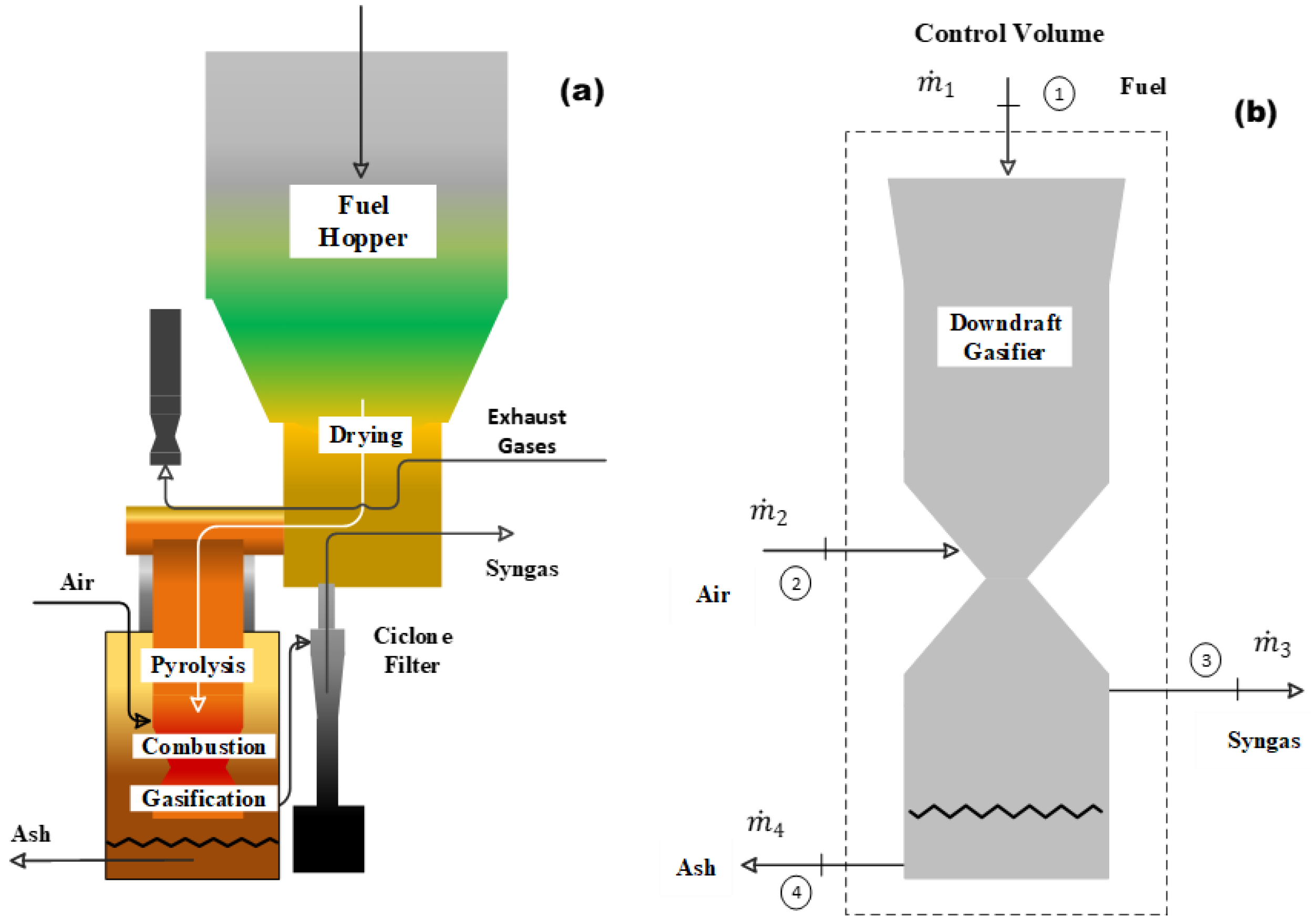
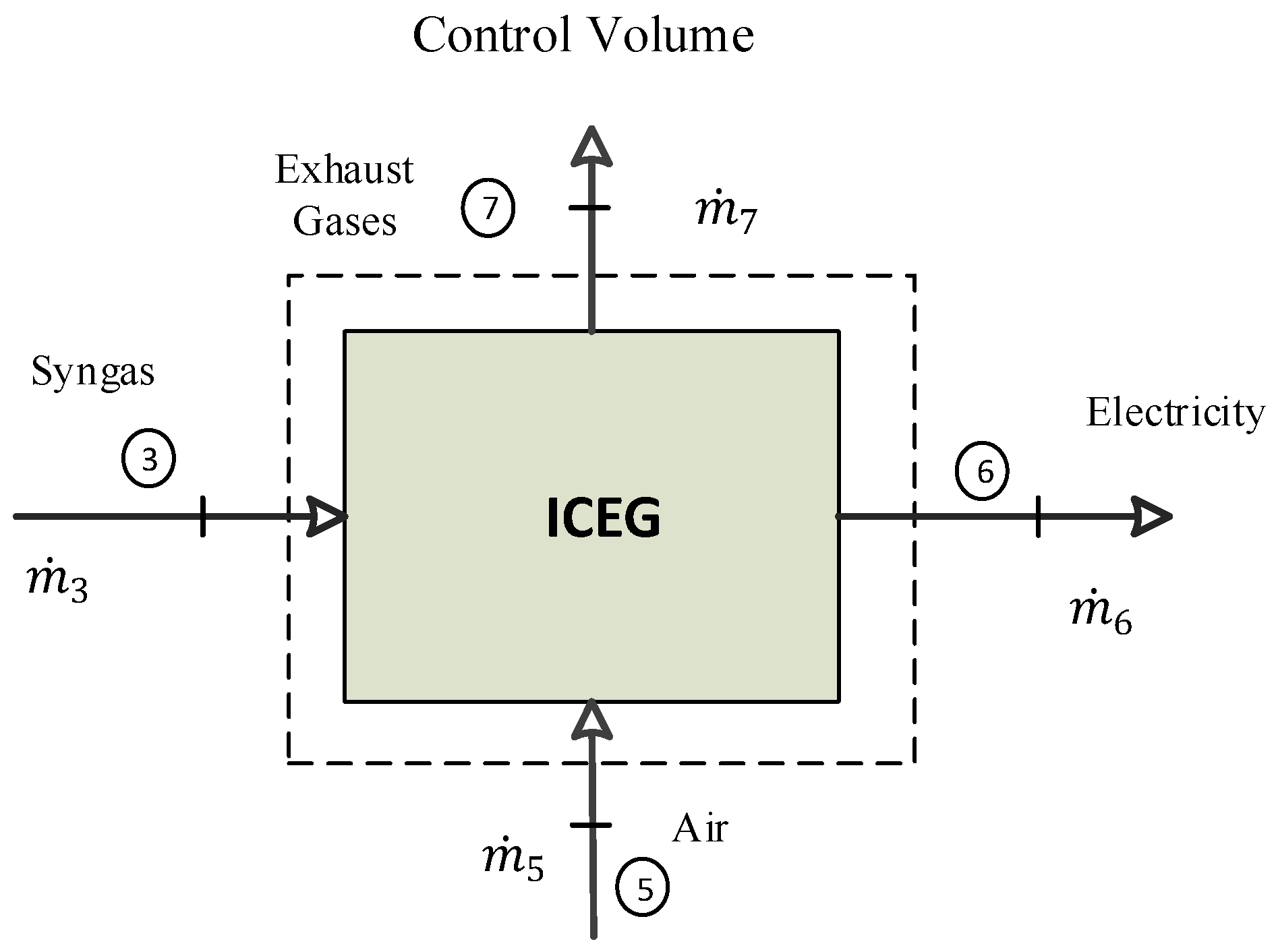
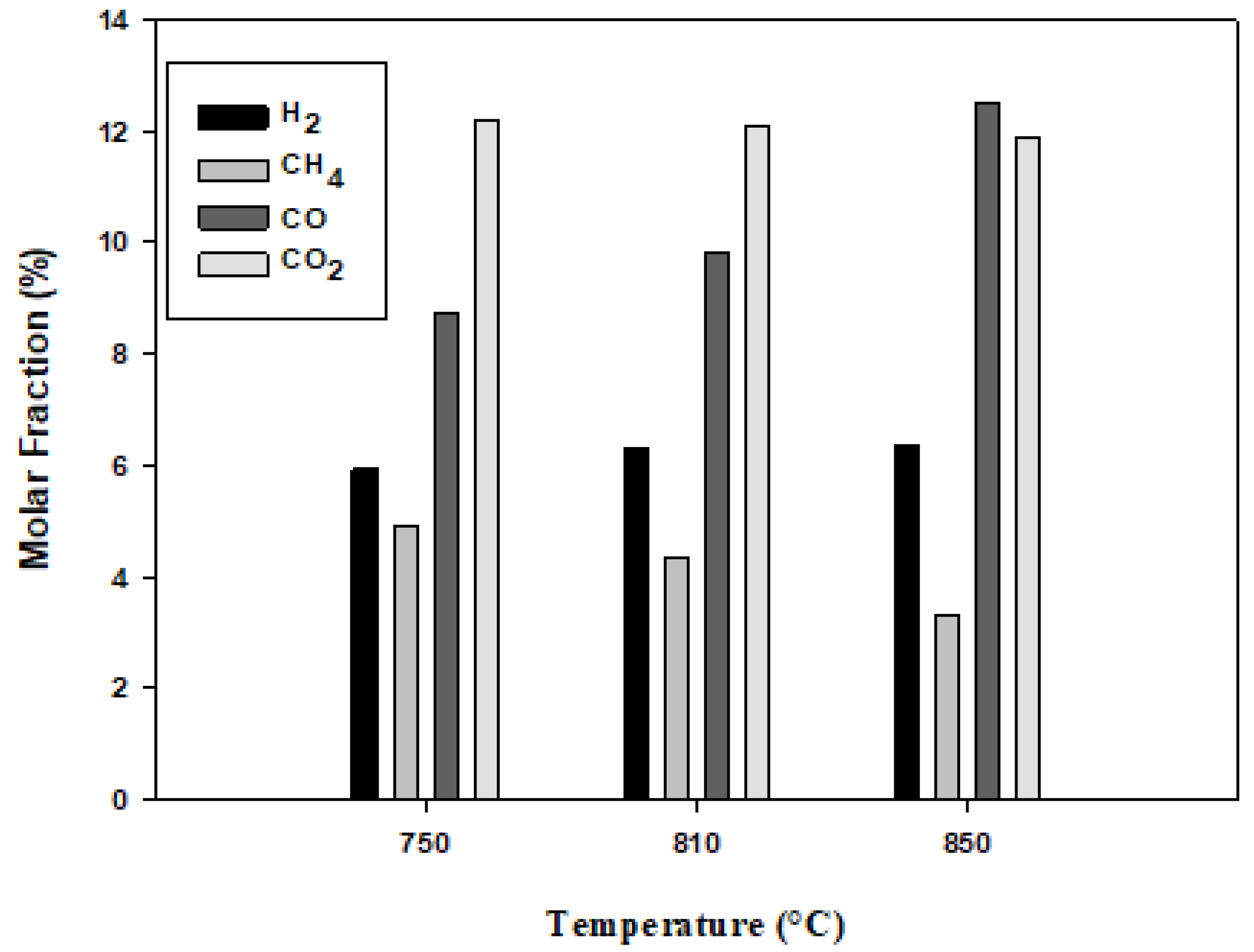
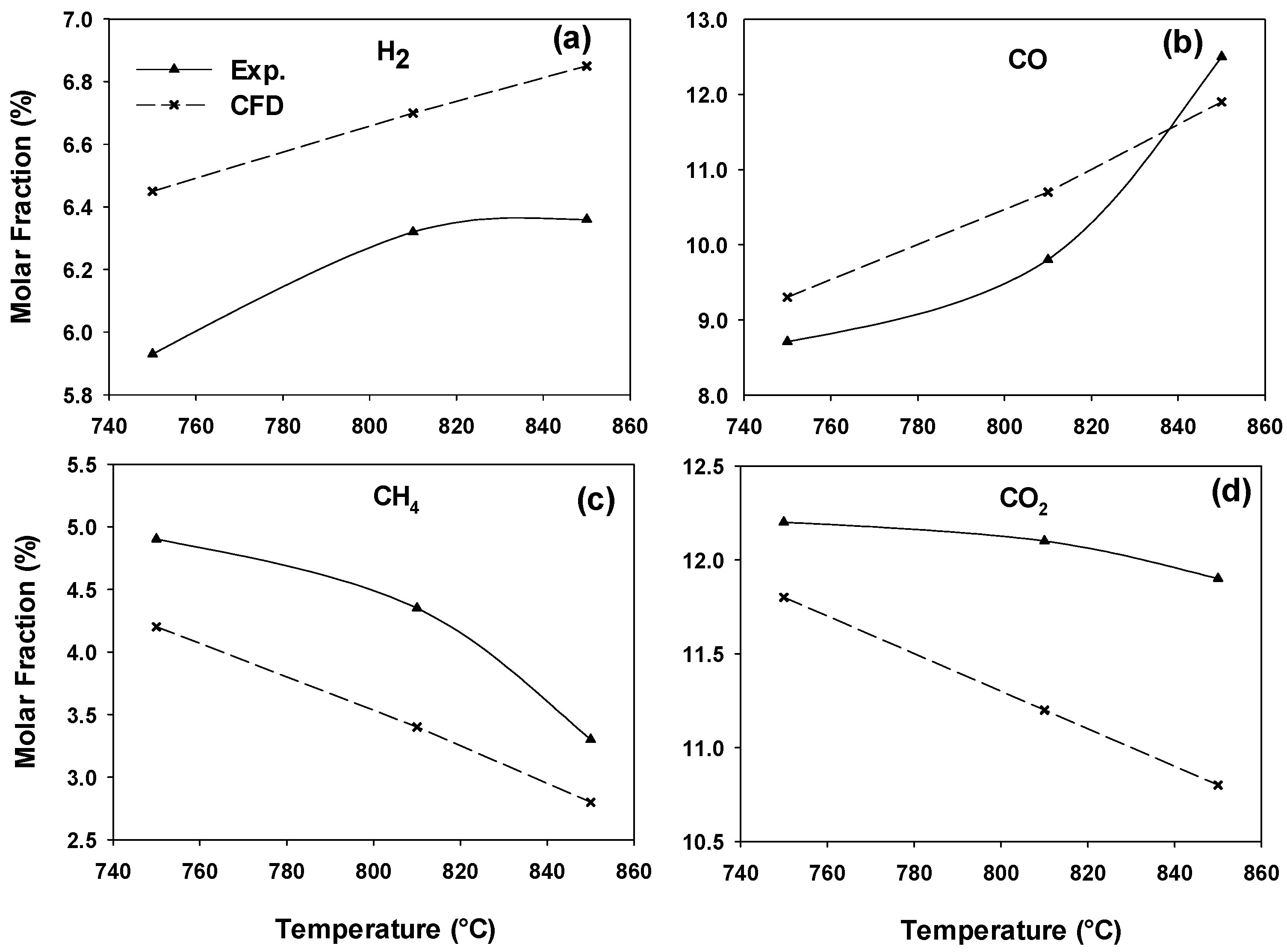
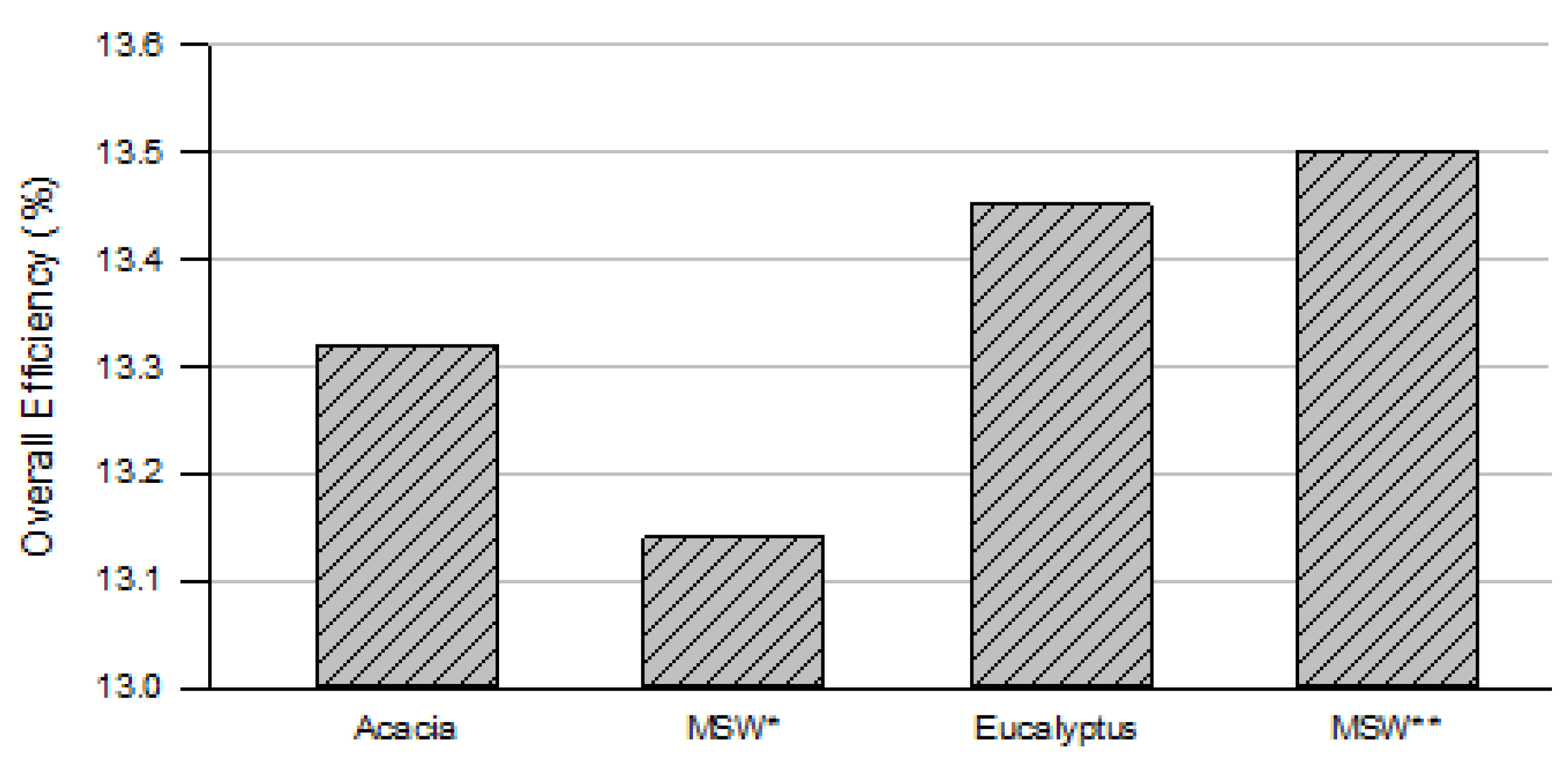


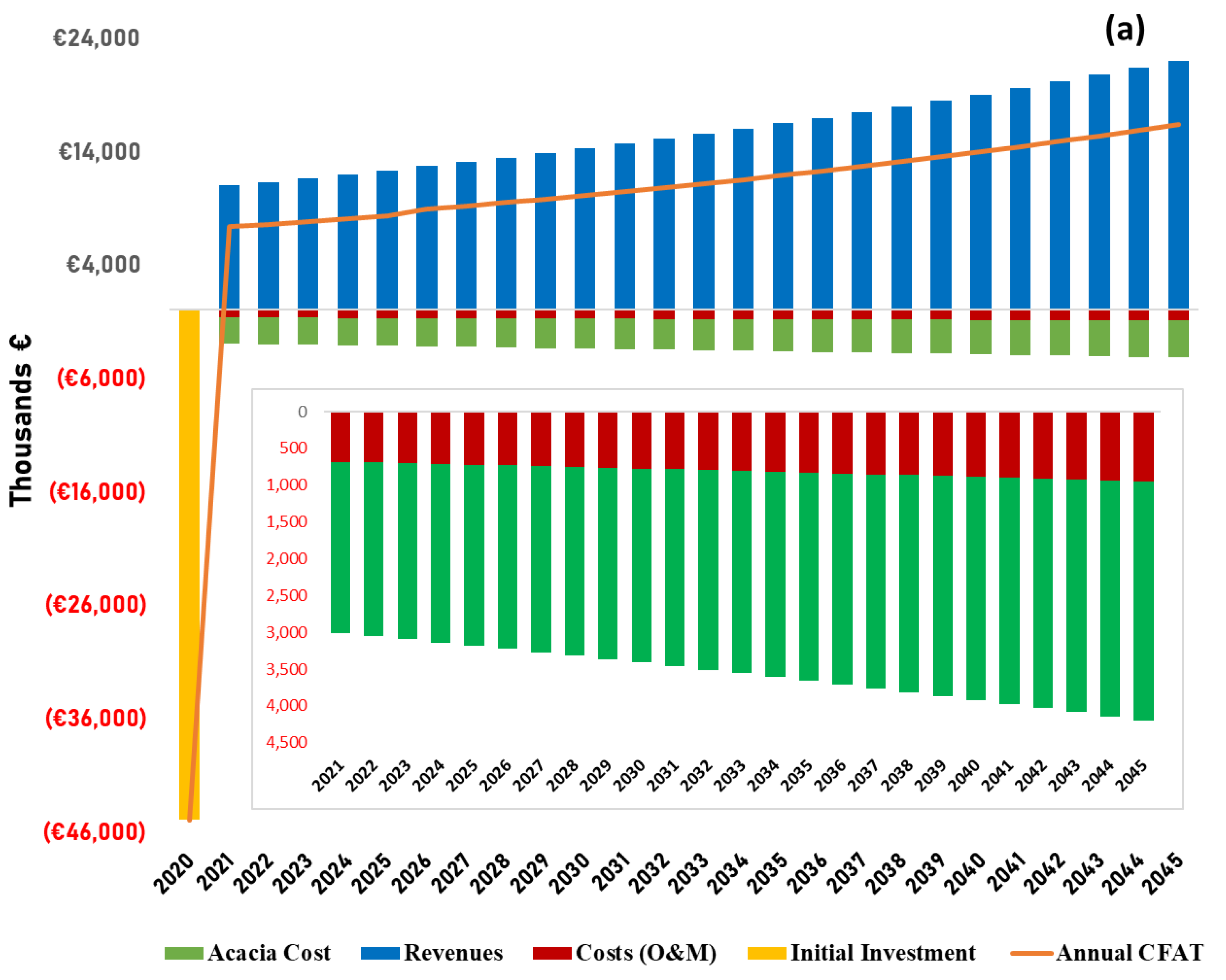


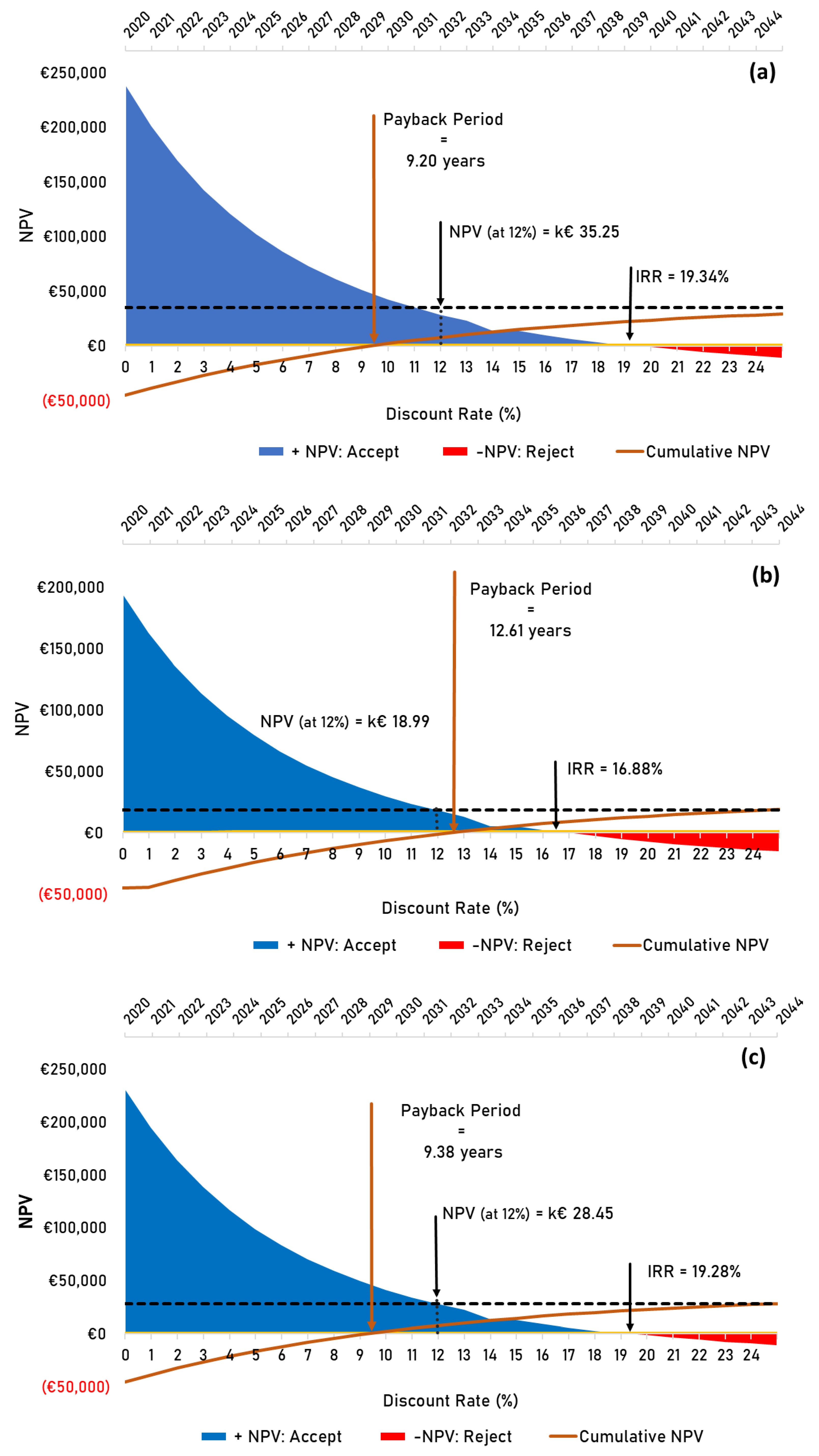

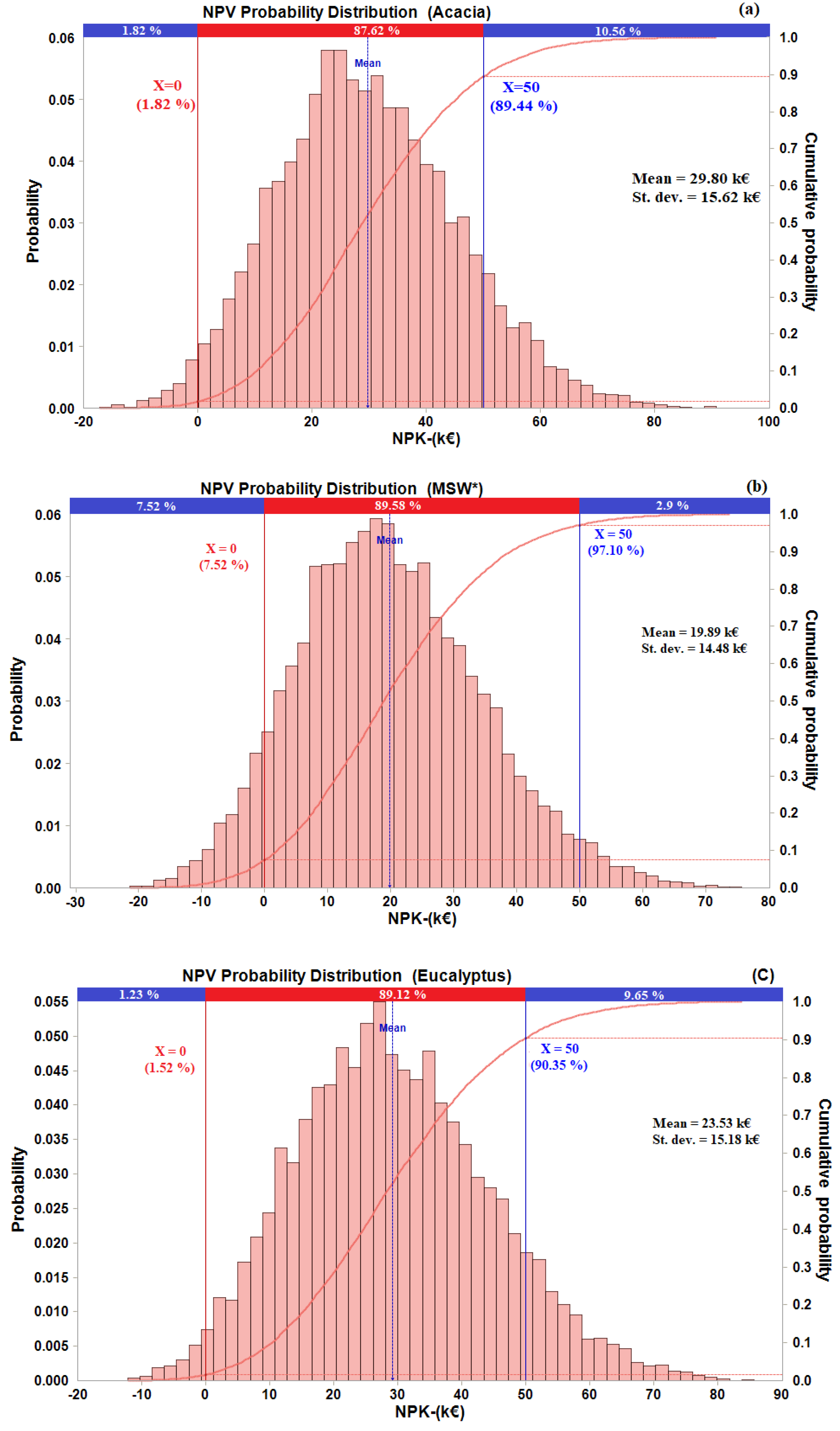

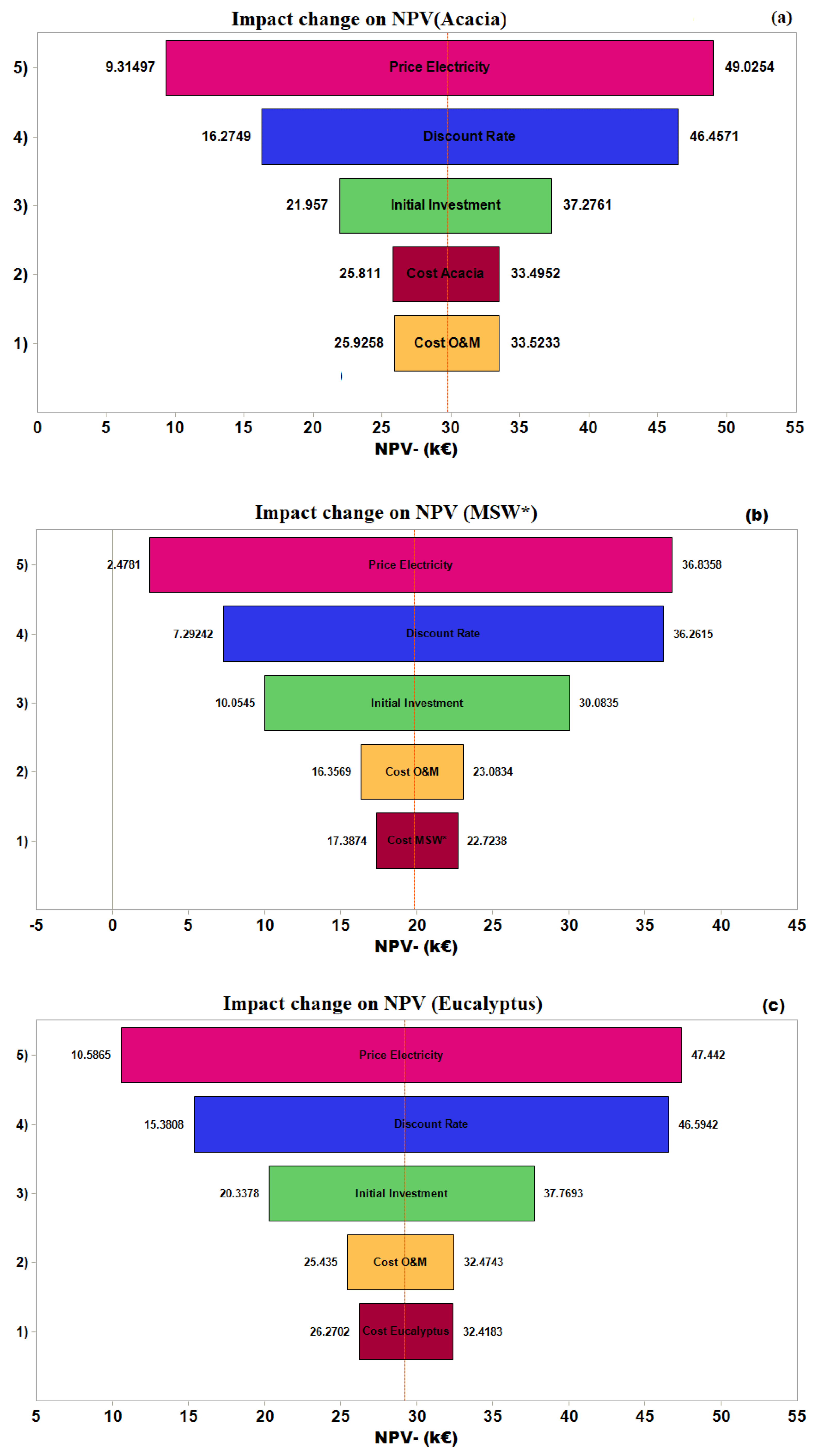
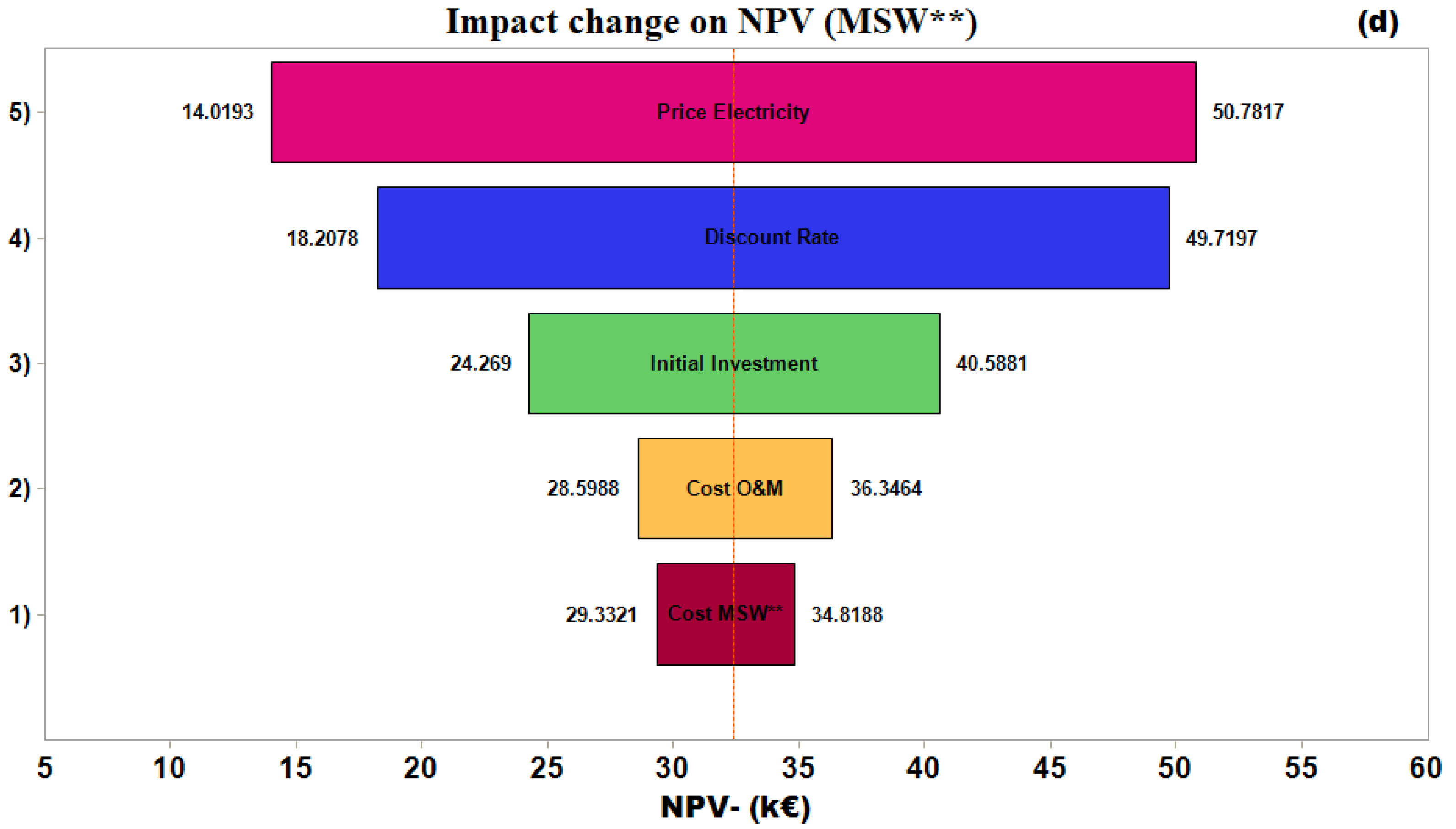
| Authors | Year | Case Study | Syngas LHV (MJ/Nm3) | Original Fuel | Max. Power (kW) | Efficiency (%) |
|---|---|---|---|---|---|---|
| Coronado et al., [19] | 2011 | Analyzes the gasification in a wood downdraft and its integration with a compact cogeneration system for applications in rural communities in Brazil. | 5.6 | Gasoline; NG | 15 | 21.4 (Elec. eff. ICE) |
| Luz et al. [20] | 2015 | Study MSW downdraft gasification for electricity generation from ICE and possible applications in small municipalities in Brazil. | 4.6 | Gasoline | 97 | 23 (Elec. eff.) |
| Raman et al. [21] | 2013 | Analyzes the performance of an ICE fed with syngas generated in a downdraft gasifier | 5.6 | NG | 73 | 21 (Overall eff.) |
| Indrawan et al. [22] | 2017 | Study the gasification of low-density biomass (Switchgrass), in a downdraft gasifier modified and the application of syngas for the generation of electricity in ICE. | 6 to 7 | NG | 5 | 21.3 (Elec. eff.) |
| La Villetta et al. [23] | 2018 | The downdraft gasification of wood chips is analyzed and the use of syngas to feed the cogeneration system, consisting of an ICE and two heat exchangers with capacity for 20 kW electric and 40 kW thermal. | 3.7 | Gasoline | 20 | 22.1 (Elec. eff.) |
| Chang et al. [24] | 2019 | Analyzes the joint generation of electricity and heat from the downdraft gasification of rice hulls in the context of Taiwan | 3.0 | NG | 1150 | 27.9 (Elec. eff.) |
| Engine | Generator |
|---|---|
| • Model: GM Vortec 3.0 L | •Model: Mecc Alte NPE 32 |
| • 4 strokes | • Frequency: 50/60 Hz |
| • Fuels: Gasoline, LPG, NG | • Number of poles: 4 |
| • Compression value: 9.4:1 | • 2250 rpm |
| • Max power: 37 kW | • Cos φ: 0.8 |
| • Max power torque: 73 Nm | • Power: 25 kVA-20 kW |
| • Max rotation: 3000 rpm | • 220 V: 32.8 A |
| LPG: Liquefied Petroleum Gas; NG: Natural Gas. | |
| Portugal | Brazil | |||
|---|---|---|---|---|
| Acacia Residues | MSW * [28] | Eucalyptus [29] | MSW ** [20] | |
| Elemental Analysis (wt.%, Dry Basis) | ||||
| C | 44.1 | 48.0 | 49.0 | 49.7 |
| H | 5.6 | 6.3 | 6.3 | 7.2 |
| N | 0.4 | 1.4 | 0.2 | 0.8 |
| S | 0.0 | 0.7 | 0.1 | 0.7 |
| O (by difference) | 49.9 | 43.6 | 44.4 | 41.6 |
| Proximal Analysis (wt.%, Wet Basis) | ||||
| Moisture | 14.2 | 17.6 | 11.3 | 6.5 |
| Ash | 4.0 | 14.9 | 0.8 | 14.3 |
| Volatile matter | 49.7 | 76.6 | 72.7 | 74.1 |
| Fixed carbon | 32.1 | 8.5 | 15.2 | 5.1 |
| LHV (MJ/kg) | 17.0 | 14.4 | 18.4 | 19.6 |
| Conservation Equations |
|---|
| Energy (gas phase): |
| Mass (gas phase): |
| Momentum (gas phase): |
| Energy (solid phase): |
| Mass (solid phase): |
| Momentum (solid phase): |
| Hydrodynamic model |
| Kinetic energy: |
| Dissipation rate: |
| Granular Eulerian model: |
| Type. | Chemical Reactions and Arrhenius Rate |
|---|---|
| Pyrolysis | |
| Homogeneous reactions | ; |
| ; | |
| Heterogeneous reactions | |
| Item | Value | Remarks | Ref. |
|---|---|---|---|
| IGasifier (€/kW) | 2500 | Costs related to the acquisition of the downdraft biomass gasifier, gas cleaning and conditioning system. Applied to both systems. | [27] |
| IICEG (€/kW) | 500 | Costs related to the acquisition of the internal combustion engine and electric generator. Applied to both systems. | [27] |
| CElectricity Portugal (€/kWh) | 0.12 | Electricity sales price practiced in Portugal. | [35] |
| CElectricity Brazil (€/kWh) | 0.14 | Electricity sales price practiced in Brazil. | [36] |
| CO&M (%) | 10 | Operation and maintenance (O & M) costs refer to 10% of the total investment, applied accordingly to both systems. Includes salaries, electricity, water, ash removal and equipment maintenance costs. | [27] |
| CAcacia (€/t) | 35 | Acacia acquisition costs for Portugal include transportation and conditioning (drying and splintering). | [25] |
| CMSW* (€/t) | 23 | MSW acquisition costs for Portugal. | [37] |
| CEucalyptus (€/t) | 33 | Eucalyptus acquisition costs for Brazil include transportation and conditioning (drying and splintering). | [31] |
| CMSW** (€/t) | 25 | MSW acquisition costs for Brazil. | [20] |
| i (%) | 12 | Average discount rate considered per year. Applied to both systems. | [20] |
| Taxation (%) | 15 | Performance tax for small and medium-sized companies in mainland Portugal | [38] |
| 17 | Performance tax for small and medium-sized companies in Brazil | [39] |
| Experimental Conditions | Acacia Residues | ||
|---|---|---|---|
| Run | 1 | 2 | 3 |
| Temperature (°C) | 750 | 810 | 850 |
| Biomass mass flow rate (kg/h) | 15.8 | 15.8 | 11.5 |
| Air flow rate (Nm3/h) | 18.0 | 18.0 | 28.0 |
| Moisture (%) | 14.2 | 14.2 | 14.2 |
| Acacia | MSW * | ||||||||
| Pts | (kg/h) | P (kPa) | T (°C) | E (kW) | Pts | (kg/h) | P (kPa) | T (°C) | E (kW) |
| 1 | 22.0 | 101.3 | 25.0 | 103.9 | 1 | 22.0 | 101.3 | 25.0 | 88.0 |
| 2 | 59.4 | 101.3 | 25.0 | - | 2 | 48.1 | 101.3 | 25.0 | - |
| 3 | 81.4 | 101.3 | 25.0 | 59.1 | 3 | 70.1 | 101.3 | 25.0 | 64.2 |
| 4 | 0.01 | 101.3 | 25.0 | - | 4 | 0.03 | 101.3 | 25.0 | - |
| 5 | 440.1 | 101.3 | 25.0 | - | 5 | 428.3 | 101.3 | 25.0 | - |
| 6 | - | - | - | 10.64 | 6 | - | - | - | 11.6 |
| 7 | 521.48 | 101.3 | 450.0 | 63.1 | 7 | 493.0 | 101.3 | 450.0 | 52.6 |
| Eucalyptus | MSW ** | ||||||||
| Pts | (kg/h) | P (kPa) | T (°C) | E (kW) | Pts | (kg/h) | P (kPa) | T (°C) | E (kW) |
| 1 | 21.8 | 101.3 | 25.0 | 111.5 | 1 | 20.4 | 101.3 | 25.0 | 111.1 |
| 2 | 41.2 | 101.3 | 25.0 | - | 2 | 64.8 | 101.3 | 25.0 | - |
| 3 | 63.0 | 101.3 | 25.0 | 83.3 | 3 | 85.2 | 101.3 | 25.0 | 83.3 |
| 4 | 0.02 | 101.3 | 25.0 | - | 4 | 0.03 | 101.3 | 25.0 | - |
| 5 | 483.7 | 101.3 | 25.0 | - | 5 | 435.4 | 101.3 | 25.0 | - |
| 6 | - | - | - | 15.0 | 6 | - | - | - | 15.0 |
| 7 | 546.7 | 101.3 | 450.0 | 68.3 | 7 | 520.6 | 101.3 | 450.0 | 68.3 |
| Downdraft Gasifier Parameters | Engine Parameters | |||||||||||
|---|---|---|---|---|---|---|---|---|---|---|---|---|
| Type of Biomass | Capacity (kg/h) | ER | Cold Gas Efficiency (%) | Syngas LHV (MJ/Nm3) | Engine Size (kW) | Original Fuel Type | Original Engine Efficiency (%) | Performed Modifications | Maximum Brake Power Produced (kW) | Specific Fuel Consumption (kg/kWh) | Efficiency (%) | Ref. |
| Acacia, MSW *, Eucalyptus, MSW ** | 22 | 0.3 | 73 to 75 | 3 to 4.5 | 20 | Gasoline; GN | 28 to 30 | Adapted carburetor | 13 to 15 | 3 to 4 | 13.5 (Overall efficiency) | This study |
| Eucalyptus | 20 to 30 | N/A | 69 | 5.5 | 10 | Gasoline; NG | 28 to 32 | Adapted carburetor | 5.2 | N/A | 12.8 (Electrical efficiency Gasifier -ICEG) | [13] |
| MSW | 140 | 0.3 | 75 | 4.6 | 96 | Gasoline | 33 | N/A | 97 | 3.5 | 23 (Electrical efficiency ICEG) | [20] |
| Wood chips | 87 | 0.3 to 5 | 88 | 5.6 | 100 | NG | N/A | Adapted carburetor | 73 | 3.21 | 21 (Overall efficiency) | [21] |
| Switchgrass | 100 | 0.2 to 5 | 80 | 6 to 7 | 10 | NG | 28 | Air fuel intake | 5 | 1.9 | 21.3 (Electrical efficiency ICEG) | [22] |
| Longan tree charcoal | 5 to 6 | N/A | N/A | 4.64 | 8.2 | Diesel | 30 to 35 | Converted to SI engine, develop new carburetor | 3.17 | 5.53 | 23.5 (Mechanical efficiency ICEG) | [48] |
| Fuel | IRR | PBP | ||
|---|---|---|---|---|
| Mean (%) | St. dev (%) | Mean (Years) | St. dev. (Years) | |
| Acacia | 19.31 | 0.03 | 10.35 | 3.90 |
| MSW * | 17.05 | 0.03 | 13.95 | 5.52 |
| Eucalyptus | 19.46 | 0.03 | 10.23 | 5.30 |
| MSW ** | 20.32 | 0.03 | 9.37 | 3.21 |
| Fuel | Power (kW) | Discount Rate (%) | NPV (k€) | IRR (%) | PBP (Years) | Ref. |
|---|---|---|---|---|---|---|
| Acacia MSW * Eucalyptus MSW ** | 13.8 11.6 15.0 15.0 | 12 | 35.25 18.89 28.45 31.65 | 19.34 16.88 19.28 20.09 | 9.20 12.61 9.38 8.67 | Present study |
| Olive tree pruning | 70 | N/A | 302 | N/A | 5 | [50] |
| Eucalyptus | 10 | 12 | N/A | N/A | 5 | [13] |
| Pellet | 48 | 7 | 81 | 10.2 | 8 | [16] |
| Agricultural Residues | 1000 | N/A | 3250 | 18.1 | 7.8 | [51] |
© 2020 by the authors. Licensee MDPI, Basel, Switzerland. This article is an open access article distributed under the terms and conditions of the Creative Commons Attribution (CC BY) license (http://creativecommons.org/licenses/by/4.0/).
Share and Cite
Copa, J.R.; Tuna, C.E.; Silveira, J.L.; Boloy, R.A.M.; Brito, P.; Silva, V.; Cardoso, J.; Eusébio, D. Techno-Economic Assessment of the Use of Syngas Generated from Biomass to Feed an Internal Combustion Engine. Energies 2020, 13, 3097. https://doi.org/10.3390/en13123097
Copa JR, Tuna CE, Silveira JL, Boloy RAM, Brito P, Silva V, Cardoso J, Eusébio D. Techno-Economic Assessment of the Use of Syngas Generated from Biomass to Feed an Internal Combustion Engine. Energies. 2020; 13(12):3097. https://doi.org/10.3390/en13123097
Chicago/Turabian StyleCopa, J. R., C. E. Tuna, J. L. Silveira, R. A. M. Boloy, P. Brito, V. Silva, J. Cardoso, and D. Eusébio. 2020. "Techno-Economic Assessment of the Use of Syngas Generated from Biomass to Feed an Internal Combustion Engine" Energies 13, no. 12: 3097. https://doi.org/10.3390/en13123097
APA StyleCopa, J. R., Tuna, C. E., Silveira, J. L., Boloy, R. A. M., Brito, P., Silva, V., Cardoso, J., & Eusébio, D. (2020). Techno-Economic Assessment of the Use of Syngas Generated from Biomass to Feed an Internal Combustion Engine. Energies, 13(12), 3097. https://doi.org/10.3390/en13123097









